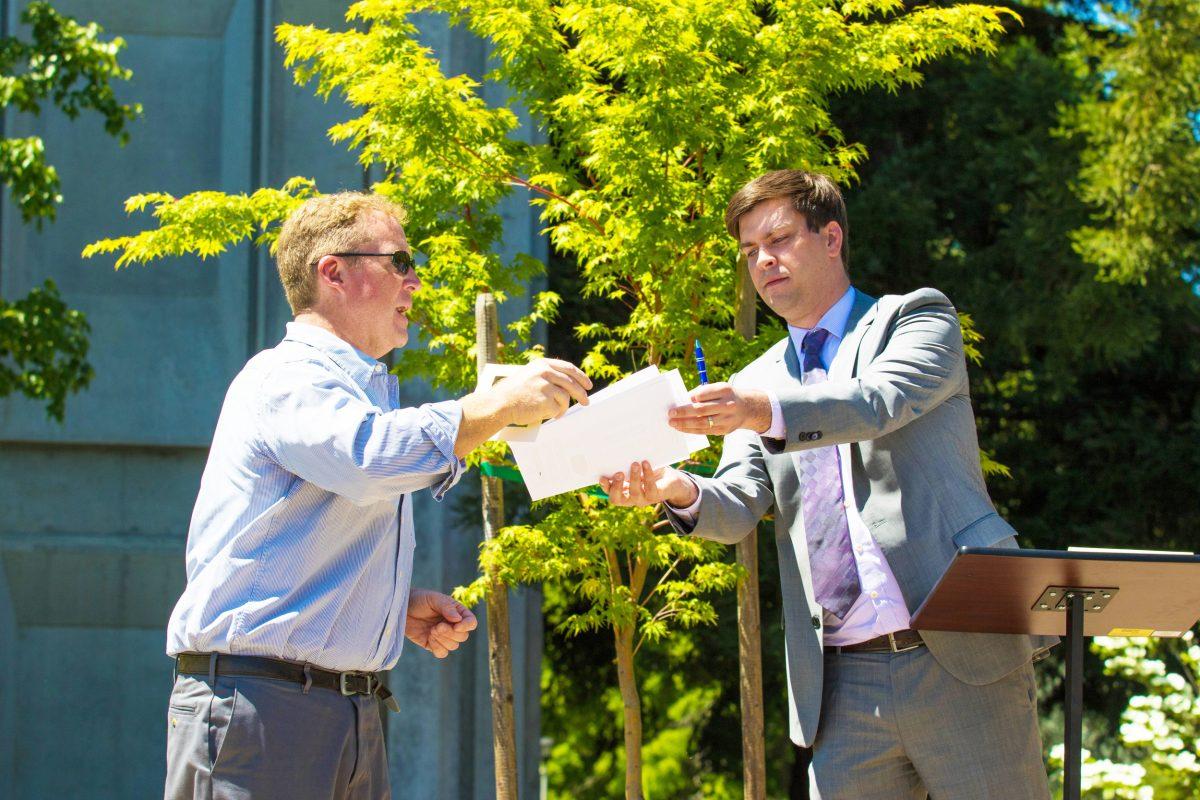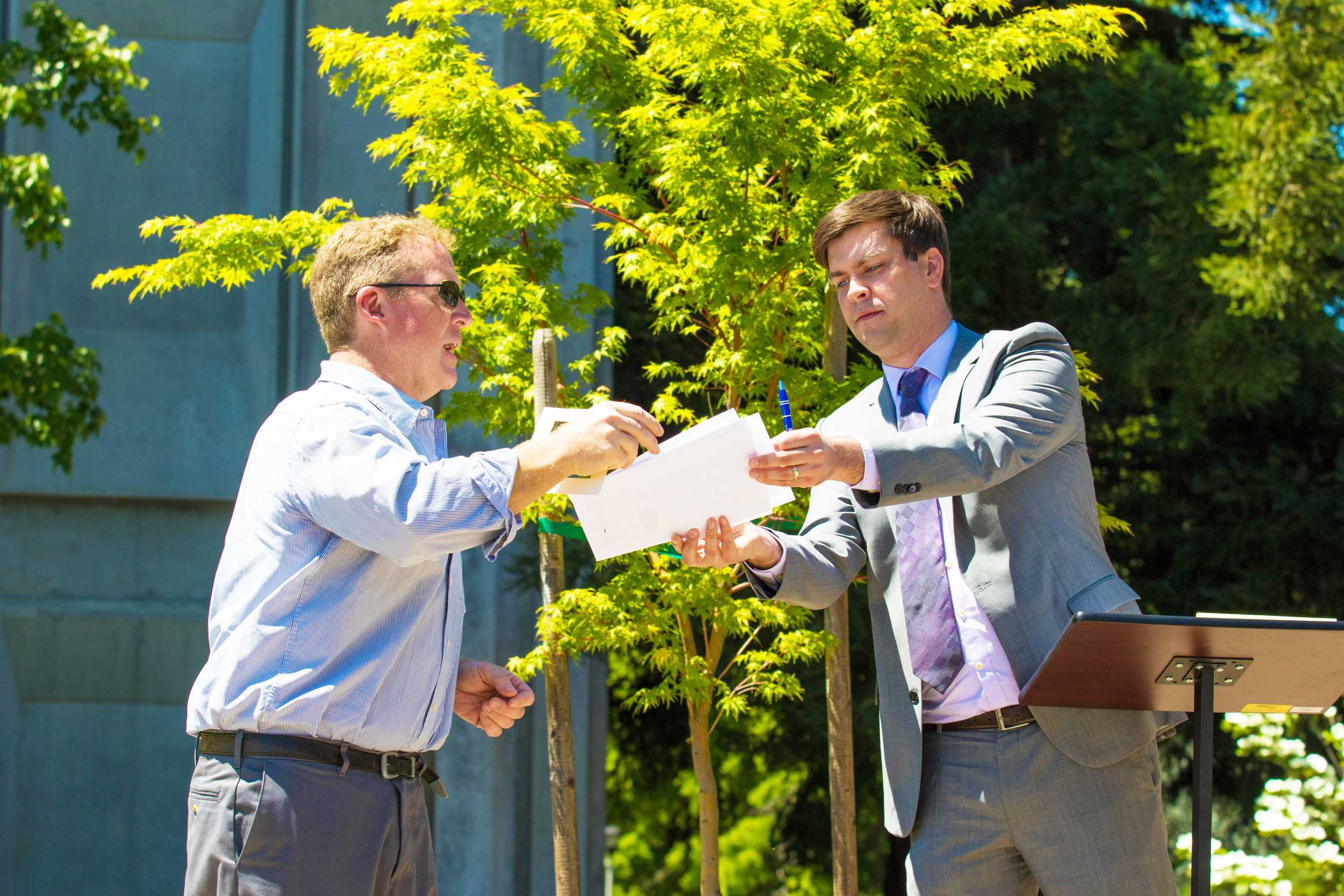The Mario Savio Speakers’ Corner serves the purpose to promote freedom of speech and civil rights at Sonoma State University. It’s also where former Sonoma State employee Thomas Sargent and his lawyers held a press conference last Thursday regarding the controversial asbestos situation in Stevenson Hall. In the conference, Sargent and his lawyers challenged the university to address the accusations.
“We are bringing this lawsuit not just on behalf of Thomas Sargent,” said Dustin Collier, Sargent’s primary lawyer. “But on behalf of a thousand potentially affected employees.”
Sargent filed a lawsuit in November against the Board of Trustees of the California State University with reference to “willful ignorance” from Sonoma State’s administration regarding the alleged asbestos hazard in Stevenson Hall. Sargent is a certified asbestos consultant and was an employee of the Environmental Health and Safety Department at Sonoma State for 24 years.
In his lawsuit, Sargent alleges that during his employment at the university he raised concerns about the way asbestos and lead paint chips were being managed in several campus buildings.
Concerned about the wellbeing of students, faculty and staff, Sargent claims to have contacted several governmental agencies to speak about the unsafe working conditions at Sonoma State. According to the lawsuit, Sargent was then retaliated against to the point where he felt the need to resign.
During last week’s press conference, Sargent began by speaking about what he called the “misleading tests” that are being conducted by Sonoma State’s administration and the results being posted on the university’s website.
Sargent is referring to the test results available on the university’s Environmental Health and Safety website, which indicate a “non-detect” level of asbestos has been found in most areas in which the toxic substance is known to exist at Sonoma State.
“Non-detect examples are not zero,” said Sergeant. “And can be as high as 5,700 asbestos structures.”
The Occupational Safety & Health Administration (Cal-OSHA), states on their website there are no safe levels of asbestos. They also say that an exposure as short as a few days can cause mesothelioma in humans, a form of cancer in the mesothelial tissues of the lungs.
According to a representative of Cal-OSHA, “non-detect” levels of asbestos may or may not be dangerous, depending on the method of testing. Sargent tested the asbestos levels in the dust in Stevenson Hall, while Sonoma State tested the air. Both testings showed contrasting reports of asbestos levels, a point of controversy in the on-going asbestos case.
Through a press release, Sonoma State University claims it has followed Cal-OSHA’s and the Environmental Protection Agencystandards by installing an asbestos management program since the early 1990s.
They are also conducting air monitoring on a monthly basis using EPA air sampling methodology, and say the university will take immediate action to reduce or eliminate risk, should airborne asbestos exceed EPA or Cal-OSHA limits.
During the press conference, Sargent also disclosed new results of a test recently conducted in regards to his litigation.
“In Stevenson Hall, there is a book shelf with 22,000,000 asbestos structures,” said Sargent. “Sooner or later somebody is going to pull those books down.”
The asbestos structures found by Sargent’s testing firm on the bookshelf are located in settled dust. The university continues to assert the only time asbestos are a hazardous is when they are present in the air. To that, Sonoma State cites the Environmental Protection Agencywhich claims, asbestos exposure results from breathing in asbestos fibers and that it is not a problem if it is left alone and not disturbed.
Collier stated in the conference the university is ignoring their results in order to not spend the “astronomical” sum abatement would implicate.
Collier also said the university should act in the interest of the people, questioning the motives of the administration.
“Our lawsuit is about the university allowing unsafe working conditions to persist.” said Collier. “Thereby creating the risk of exposure.”
Collier ended the conference with a challenge to the university.
“If we all agree that asbestos is only dangerous when disturbed, I challenge the university today, to answer the question why they are not testing under disturbance activities,” asked Collier.





![[Both photos courtesy of sonoma.edu]
Ming-Ting Mike Lee stepped in as the new SSU president following Sakakis resignation in July 2022](https://sonomastatestar.com/wp-content/uploads/2024/04/CC4520AB-22A7-41B2-9F6F-2A2D5F76A28C-1200x1200.jpeg)



























